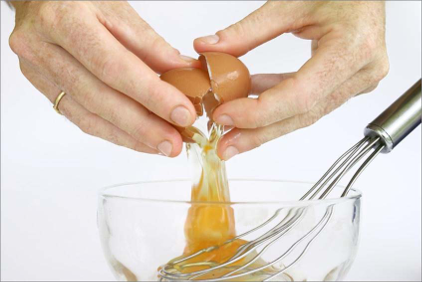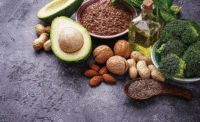The Art of Emulsifications

|
Emulsion by the Numbers |
|
Mix 100mL vegetable oil with 500mL of water to obtain an emulsion with oil droplets having an average diameter of 1um then 600 m2 of water/oil surface interface is created. To create this emulsion, the energy of mixing is converted into surface energy. The addition of 1% of a standard emulsifier reduces this surface energy 10 times |
Eggs are a classic, science-based method of creating stable emulsifications from two or more unmixable components. This article, derived from a recent workshop “Emulsifications,” conducted during the National Egg Products School by Christine Alvarado, Ph.D., of Texas A&M University, College Station, in which she describes the basics behind egg-based emulsifications.
An emulsion is defined as a mixture containing two liquid phases that are normally immiscible, under ordinary conditions. Typically, it is comprised of a lipid and a water-based pair of components. Examples of emulsions include dispersions of tiny particles of one liquid into another immiscible (unmixable) liquid. The particles are larger than molecules, but less than one-thousandth of a millimeter (0.001mm). In a dispersed phase, you essentially have droplets evenly distributed throughout the mixture. These are usually not stable and the components can easily separate.
A continuous phase emulsion is a matrix, and relies on an interface between the major components. Egg yolk, whole egg and egg white are all good emulsifiers for food products because they increase the emulsion stability, acting as a strong interface.
Emulsions and emulsifiers are very important to the food industry, but while it is important to know the properties of these emulsions, it also is critical to understand that those same properties depend on the composition and preparation of the emulsion.
Many emulsions tend to destabilize and separate into layers. This is why some formulations require addition of a stabilizer. A stabilizer is any ingredient that enhances emulsion, and can itself be an emulsifier or it can be a thickening agent. Emulsion stability can be increased by an emulsifier or surfactant that reduces surface and interfacial tension. These make emulsion formation easier. Thickening agents can add to emulsion stability by increasing viscosity and making droplet movement harder.
In a water-lipid emulsification, the emulsifier has polar, hydrophilic (“water-loving”) and non-polar lipophilic (“fat-loving”) ends. This duality is termed “amphiphilic.” The amphiphilic agent forms a protective layer at the surface of droplets and prevents them from aggregating.
|
A Comparison of Classic Emulsifications Mayonnaise
|
|
Mayonnaise
6% egg yolk, 80% oil
Caesar Salad Dressing
9% egg yolk, 63% oil
Hollandaise Sauce
15% egg yolk, 74% butter
Béarnaise Sauce
13% egg yolk, 64% butter
|
Chemically, emulsions rectify surface active and interfacial tension. Like molecules are attracted to each other and prefer to stay together—think of liquid droplets on glass. The forces attracting water are different at the surface versus the interior, causing an elastic sheet on the surface. (This is the same force that allows insects to walk on water.)
This same thing happens in an emulsion, where two liquids come together—interface—while surface active agents (surfactants) block the water molecules’ interaction. This reduces the attractive forces and the surface tension, forming a protective layer.
The role of emulsifiers in food emulsions includes promoting or creating an emulsion by reducing the force required to create the tiny particles or droplets. The emulsifier also stabilizes a mixture by reducing surface tension. The fundamental formula of an emulsification is oil + water +emulsifiers + energy. Resting energy exists at the oil-water interface, in the interfacial tension and in surface tension.
Promoting an emulsion and stabilizing an emulsion are quite different. When two oil droplets make contact they tend to coalesce to form a single, larger droplet. If an emulsion stands for a long time, the droplets will rise to the top or “cream.” If an emulsifier is present, the droplets formed are smaller and take longer to cream. The mixing stage of emulsification subdivides the dispersed phase into droplets.
Each time the droplets are subdivided, the greater the interfacial tension (energy). When surfactants/emulsifiers are included into the mix, molecules migrate to the oil/water interface, thus the surfactant is more concentrated at the interfacial region than in the bulk. While emulsifiers are surfactants, not all surfactants are good emulsifiers.
Emulsions not only combine repelling ingredients, they in turn provide stability. A key ability of emulsion is to resist change in its properties with time. This includes creaming, with droplets having lower density than liquid and rising to the top of the mix. Or, sedimentation, with droplets having higher density than liquid and sinking to the bottom. There also is flocculation, in which individual droplets clump and coalescence, where droplets merge to form a larger single droplet.
Eggs are one of the most hydrophilic emulsifiers used in the food industry and the most prevalent dough strengthener. As an emulsifier, eggs are very strong and efficient. This is due to their phospholipids, lipoproteins and proteins found in egg yolks (or whole egg). Egg yolks can be used to fortify whole-egg blends to increase emulsifying action. Also, for formulators, eggs are highly versatile. No essential differences are found in the emulsifying properties of dried wholes egg and yolk and fresh liquid eggs.
One of the primary egg components that acts as an emulsifier is the phospholipid lecithin. Egg yolk provides a viscous, continuous phase that prevents coalescence of the dispersed water droplets, promoting stability and thickening. Yolk solids content will affect emulsifying properties, that is, increasing solids brings on better emulsification. The stability of egg-yolk emulsion systems can be further improved by adding 0.5% sodium-2-lactylate.
There are several factors that negatively affect emulsification. These include freezing, which causes gradual denaturation of yolk proteins and an increase in viscosity. The freeze-thaw cycle leads to an irreversible gelation of yolk and reduces emulsifying capacity and stability. However, 10% salt or sugar added prior to freezing will prevent gelation. High temperature (such as pasteurization), specifically at or above 178°F, reduces emulsifying capacity. Also, the introduction of an acid (such as acetic acid) decreases emulsifying capacity, as does drying. Salt, however, can increase emulsion stability, as will adding 5-10% sucrose, especially before drying. The salt maintains yolk emulsifying capacity.
Some egg processors offer an enzyme-modified egg yolk. Phospholipase converts phosphatidylcholine (lecithin) to lysophosphatidyl-choline. This enzyme-modified egg yolk has high water solubility and emulsifying properties. Enzyme-modified egg yolk is available in both dried and liquid yolk products.
Mayonnaise is perhaps the most famous “modern” emulsification in food. It was said to have been invented in 1756 by the French chef of the Duc de Richelieu. After the duke beat the British at Port Mahon, his chef created a victory feast that was to include a sauce made of cream and eggs. Realizing that there was no cream in the kitchen, the chef substituted olive oil for the cream and a new culinary creation was born. The chef named the new sauce “Mahonnaise” in honor of Richelieu’s victory.
Mayonnaise is spoonable and has specific ingredients defined in its standard or identity. It is defines as the “emulsified semisolid food prepared from vegetable oil(s),” with vinegar(s) having an acidity calculated as acetic acid of not less than 2.5% (lemon or lime juice also may be used, with acidity as citric acid). Vegetable-oil content must contain an egg-yolk-containing ingredient (liquid yolks, frozen yolks or whole eggs liquid, frozen or dried). U.S. commercial standards require yolk at about 5.3-5.8% liquid egg yolk.
Egg yolk also is commonly used to make thick, spoonable salad dressings. In formulation, it also prevents ingredient separation in pourable dressings. Salad dressing has two general classifications, based on viscosity: pourable (a thinner, flowable product) and spoonable (a thicker, more plastic product). However, there are standards of identity for only three types of salad dressings in the Code of Federal Regulations (CFR): French dressing (21 CFR 169.115), Mayonnaise (21 CFR 169.140) and Salad Dressing (21 CFR 169.150).
Formulation stability can be maintained using emulsifiers, thickening agents and stabilizers. These reduce the energy required to form the emulsion and are typically polar and non-polar molecules. For this reason, liquid whole egg, egg yolks and other egg formats are commonly used in a variety of product (salad dressing, mayo, ice cream, etc.) to stabilize the emulsion.
Looking for a reprint of this article?
From high-res PDFs to custom plaques, order your copy today!





